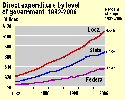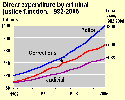| Home | About Us | Contact Us | Help | A-Z Topic List |

Interested in statistics?
Subscribe to JUSTSTATS
Get email notices of new crime and justice statistical materials as they become available from BJS, the FBI, and OJJDP.
Once you subscribe, you will receive an email notification from JUSTSTATS when updated or new information becomes available.
- Crime and Justice Electronic Data Abstract spreadsheets
Aggregated data from a wide variety of published sources, intended for analytic use. - Justice Expenditures and Employment data query tool
Build customized data tables based on justice-related activities (police protection, judicial, corrections)
| MORE DATA ANALYSIS TOOLS |
- How do I get paper copies of older reports that are not on your webpage?
- What types of justice employment and expenditure data does the Bureau of Justice Statistics collect?
- What contributions do federal, state, and local budgets make to justice expenditures in the United States?
- What percentage of public employees are devoted to criminal justice at the state and local levels, and by which functions?
- Has the cost of providing justice for the nation changed over time?
| MORE FAQs |
| On This Page |
| About this Topic |
BJS Expenditure and Employment Data Collections
Statistical Report. Provides selected data from the U.S. Census Bureau's Annual General Finance and Employment Surveys. Data includes police protection, judicial and legal services, and corrections expenditure and employment for federal, state, and local governments in 2003 and national trend data from 1982 to 2003. Expenditure data are provided for fiscal year 2003; employment and payroll data are for the month of March 2003. The report compares justice expenditure to spending for other governmental services and analyzes trends in justice spending and employment. It also presents per capita employment data relative to other state and government services, as well as per capita expenditure data by governmental function.
Justice Expenditure and Employment Extract Series. Since 1980, these justice expenditure and employment data have been extracted from the Census Bureau's Annual Government Finance Survey and Annual Survey of Public Employment. This series includes national and state-by-state estimates of government expenditures and employment for the following categories: police protection, all judicial (including prosecution, courts, and public defense), and corrections. Federal data for the same categories are also included, as are data for the largest local governments (counties with populations of 500,000 or more and cities with populations of 300,000 or more). Government is the unit of analysis in the CJEE. For example, corrections employment reported for a particular state represents the total number of correctional employees employed by that state regardless of agency or location—prison, probation office, or other corrections agency.
Summary Findings
- Local governments spent more on criminal justice direct expenditures than state or federal government.
- Direct expenditures for each of the major criminal justice functions—police, corrections, and judicial—has increased steadily since 1982.
- In fiscal year 2006, federal, state, and local governments spent an estimated $214 billion for police protection, corrections, and judicial and legal activities, a 5.1% increase over the previous year.
In 2006—
Police Protection
- Expenditure: Federal, state, and local governments spent about $98 billion on police protection.
- Employment: About 76% of employees in police protection served at the local level of government, 9.2% at the state level, and 14% at the federal level.
Judicial and Legal
- Expenditure: Federal, state and local governments spent about $46 billion for judicial and legal services nationwide.
- Employment: Over half (54%) of employees working in judicial and legal capacities served at the local level of government, 34% at the state level, and 11% at the federal level.
Corrections
- Expenditure: Federal, state and local governments spent a total of about $68 billion on corrections.
- Employment: About 61% of corrections employees served at the state level of government, 33% at the local level, and 4% at the federal level.
Justice Expenditure Highlights
In 2006—
- State and local justice cost a record $178 billion of the total $214 billion direct justice expenditures for all levels of government.
- The federal, state, and local justice cost of about $729 per person in 2006 was a 9% increase from the $669 per person cost in 1997.
Justice Employment Highlights
- Nationwide, there were 2.4 million justice employees working at the federal, state, and local levels during 2006.
- Over the decade--1997 to 2006—overall growth in justice employment for federal, state, and local governments remained relatively stable
- Police protection had the largest number of state and local justice employees.
| Key Facts |

|
Expenditure by level of government Local governments spend more on criminal justice than state governments or the federal government. Chart Page | Data Table | Spreadsheet | d_link |
|

|
Expenditure for justice functions Direct expenditure for each of the major criminal justice functions (police, corrections, judicial) has been increasing. Chart Page | Data Table | Spreadsheet | d_link |
|
| Data Collections & Surveys |
- Expenditure and employment data from other BJS sources
- Justice Assistance Data Survey (formerly Justice Expenditure and Employment Survey)
- Justice Expenditure and Employment Extracts Series
| Publications & Products |
- Publications
- Data Tables
Press Releases
| Terms & Definitions |
| Direct expenditure | All expenditure except that classified as intergovernmental. It includes "direct current expenditure" (salaries, wages, fees, and commissions and purchases of supplies, materials, and contractual services) and "capital outlays" (construction and purchase of equipment, land, and existing structures). Capital outlays are included for the year when the direct expenditure is made, regardless of how the funds are raised (for example, by bond issue) or when they are paid back. |
| Full time employees | All persons employed on a full time basis, including all full time temporary or seasonal workers who were employed during this pay period. |
| Full time equivalent employment | A statistical measure that estimates the number of full time employees that could have been employed if the reported number of hours worked by part time employees had been worked by full time employees. |
| Intergovernmental expenditure | The sum of payments from one government to another, including grants?in?aid, shared revenues, payments in lieu of taxes, and amounts for services performed by one government for another on a reimbursable or cost?sharing basis (for example, payments by one government to another for boarding prisoners). It excludes amounts paid to other governments for purchase of commodities, property, or utility services. |
| Judicial and legal services | Includes all civil and criminal courts and activities associated with courts such as law libraries, grand juries, petit juries, medical and social service activities, court reporters, judicial councils, bailiffs, and probate functions. It also includes the civil and criminal justice activities of the attorneys general, district attorneys, State's attorneys, and their variously named equivalents and corporation counsels, solicitors, and legal departments with various names. It excludes legal units of noncriminal justice agencies, whose functions may be performed by a legal services department in other jurisdictions (such as a county counsel). |
| Related Links |